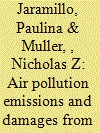|
|
|
Sort Order |
|
|
|
Items / Page
|
|
|
|
|
|
|
| Srl | Item |
| 1 |
ID:
150829


|
|
|
|
|
| Summary/Abstract |
This paper uses air pollution emissions data for the years 2002, 2005, 2008, and 2011 to estimate monetary damages due to air pollution exposure for PM2.5, SO2, NOx, NH3, and VOC from electric power generation, oil and gas extraction, coal mining, and oil refineries. In 2011, damages associated with emissions from these sectors totaled 131 billion dollars (in 2000$), with SO2 emissions from power generation being the largest contributors to social damages. Further, damages have decreased significantly since 2002, even as energy production increased, suggesting that, among other factors, policies that have driven reductions in emissions have reduced damages. The results of this analysis highlight the spatial heterogeneity of the impacts associated with the emissions of a given pollutant. In the past, environmental regulations have assumed that the benefits of air emissions reductions are homogenous across source location. This analysis suggests that policy designs that account for spatial differences in the impacts of air emissions could result in more effective environmental regulation. Accounting for such spatial heterogeneity in the benefits of policies would be akin to accounting for differences in compliances costs across states, which the EPA did when establishing the state emissions standards for the Clean Power Plan rule.
|
|
|
|
|
|
|
|
|
|
|
|
|
|
|
|
| 2 |
ID:
176772


|
|
|
|
|
| Summary/Abstract |
The deployment of wind power is a major contribution to the decarbonisation of societies. Yet, wind turbines can cause some negative externalities to humans and nature. These largely depend on the spatial allocation of the wind turbines. Therefore the question is how to design policies that minimise the social costs of wind power generation which are defined as the sum of production and external costs. An instrument which is used in Germany and elsewhere to control the externalities of wind turbines is the prescription of minimum distances to sensitive landscape features like human settlements and bird nests. The efficient (i.e. minimising social costs) magnitude of such minimum distances, however, depends on uncertain parameters. We apply a robustness analysis to an ecological-economic model for the assessment of the social costs of wind power deployment in order to identify policies, each defined by certain minimum distances, which are favourable within wide ranges of various uncertain parameters. In the examined study region in Germany, rather large minimum distances to nests of the red kite (a raptor bird) and moderate minimum distances to settlements turn out to be most favourable taken the considered uncertainties into account.
|
|
|
|
|
|
|
|
|
|
|
|
|
|
|
|
|
|
|
|
|